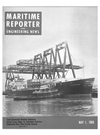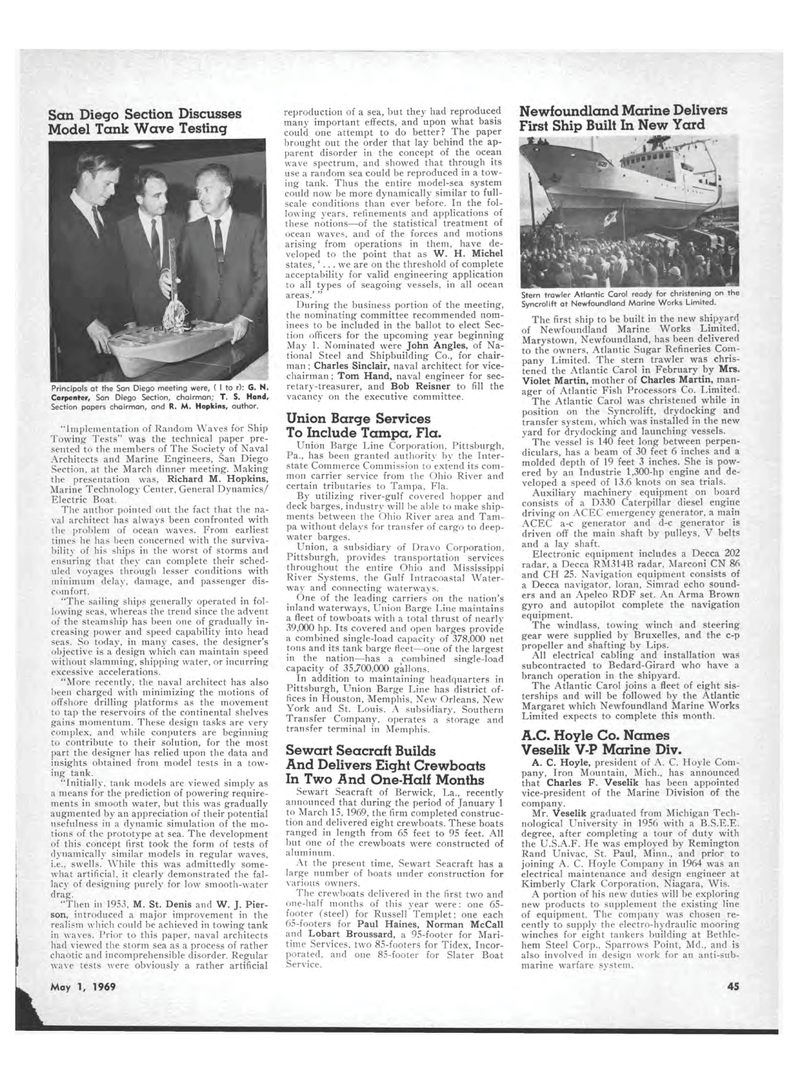
Page 43: of Maritime Reporter Magazine (May 1969)
Read this page in Pdf, Flash or Html5 edition of May 1969 Maritime Reporter Magazine
San Diego Section Discusses Model Tank Wave Testing Principals at the San Diego meeting were, ( I to r): G. N. Carpenter, San Diego Section, chairman; T. S. Hand, Section papers chairman, and R. M. Hopkins, author. "Implementation of Random Waves for Ship Towing' Tests" was the technical paper pre-sented to the members of The Society of Naval Architects and Marine Engineers, San Diego Section, at the March dinner meeting. Making the presentation was, Richard M. Hopkins, Marine Technology Center, General Dynamics/ Electric Boat. The author pointed out the fact that the na-val architect has always been confronted with the problem of ocean waves. From earliest times he has been concerned with the surviva-bility of his ships in the worst of storms and ensuring that they can complete their sched-uled voyages through lesser conditions with minimum delay, damage, and passenger dis-comfort. "The sailing ships generally operated in fol-lowing seas, whereas the trend since the advent of the steamship has been one of gradually in-creasing power and speed capability into head seas. So today, in many cases, the designer's objective is a design which can maintain speed without slamming, shipping water, or incurring excessive accelerations. "More recently, the naval architect has also been charged with minimizing the motions of offshore drilling platforms as the movement to tap the reservoirs of the continental shelves gains momentum. These design tasks are very complex, and while conputers are beginning to contribute to their solution, for the most part the designer has relied upon the data and insights obtained from model tests in a tow-ing tank. "Initially, tank models are viewed simply as a means for the prediction of powering require-ments in smooth water, but this was gradually augmented by an appreciation of their potential usefulness in a dynamic simulation of the mo-tions of the prototype at sea. The development of this concept first took the form of tests of dynamically similar models in regular waves, i.e.. swells. While this was admittedly some-what artificial, it clearly demonstrated the fal-lacy of designing purely for low smooth-water drag. "Then in 1953. M. St. Denis and W. J. Pier-son, introduced a major improvement in the realism which could be achieved in towing tank in waves. Prior to this paper, naval architects had viewed the storm sea as a process of rather chaotic and incomprehensible disorder. Regular wave tests were obviously a rather artificial reproduction of a sea, but they had reproduced many important effects, and upon what basis could one attempt to do better? The paper brought out the order that lay behind the ap-parent disorder in the concept of the ocean wave spectrum, and showed that through its use a random sea could be reproduced in a tow-ing tank. Thus the entire model-sea system could now be more dynamically similar to full-scale conditions than ever before. In the fol-lowing years, refinements and applications of these notions?of the statistical treatment of ocean waves, and of the forces and motions arising from operations in them, have de-veloped to the point that as W. H. Michel states,' ... we are on the threshold of complete acceptability for valid engineering application to all types of seagoing vessels, in all ocean areas.' " During the business portion of the meeting, the nominating committee recommended nom-inees to be included in the ballot to elect Sec-tion officers for the upcoming year beginning May 1. Nominated were John Angles, of Na-tional Steel and Shipbuilding Co., for chair-man ; Charles Sinclair, naval architect for vice-chairman ; Tom Hand, naval engineer for sec-retary-treasurer, and Bob Reisner to fill the vacancy on the executive committee. Union Barge Services To Include Tampa, Fla. Union Barge Line Corporation, Pittsburgh, Pa., has been granted authority by the Inter-state Commerce Commission to extend its com-mon carrier service from the Ohio River and certain tributaries to Tampa, Fla. By utilizing river-gulf covered hopper and deck barges, industry will be able to make ship-ments between the Ohio River area and Tam-pa without delays for transfer of cargo to deep-water barges. Union, a subsidiary of Dravo Corporation, Pittsburgh, provides transportation services throughout the entire Ohio and Mississippi River Systems, the Gulf Intracoastal Water-way and connecting waterways. One of the leading carriers on the nation's inland waterways, Union Barge Line maintains a fleet of towboats with a total thrust of nearly 39,000 hp. Its covered and open barges provide a combined single-load capacity of 378,000 net tons and its tank barge fleet?one of the largest in the nation?has a combined single-load capacity of 35.700,000 gallons. In addition to maintaining headquarters in Pittsburgh, Union Barge Line has district of-fices in Houston, Memphis, New Orleans, New York and St. Louis. A subsidiary, Southern Transfer Company, operates a storage and transfer terminal in Memphis. Sewart Seacraft Builds And Delivers Eight Crewboats In Two And One-Half Months Sewart Seacraft of Berwick, La., recently announced that during the period of January 1 to March 15, 1969, the firm completed construc-tion and delivered eight crewboats. These boats ranged in length from 65 feet to 95 feet. All but one of the crewboats were constructed of aluminum. At the present time, Sewart Seacraft has a large number of boats under construction for various owners. The crewboats delivered in the first two and one-half months of this year were: one 65-footer (steel) for Russell Templet; one each 65-footers for Paul Haines, Norman McCall and Lobart Broussard, a 95-footer for Mari-time Services, two 85-footers for Tidex, Incor-porated, and one 85-footer for Slater Boat Service. Newfoundland Marine Delivers First Ship Built In New Yard Stern trawler Atlantic Carol ready for christening on the Syncrolift at Newfoundland Marine Works Limited. The first ship to be built in the new shipyard of Newfoundland Marine Works Limited, Marystown, Newfoundland, has been delivered to the owners, Atlantic Sugar Refineries Com-pany Limited. The stern trawler was chris-tened the Atlantic Carol in February by Mrs. Violet Martin, mother of Charles Martin, man-ager of Atlantic Fish Processors Co. Limited. The Atlantic Carol was christened while in position on the Syncrolift, drydocking and transfer system, which was installed in the new yard for drydocking and launching vessels. The vessel is 140 feet long between perpen-diculars, has a beam of 30 feet 6 inches and a molded depth of 19 feet 3 inches. She is pow-ered by an Industrie 1,300-hp engine and de-veloped a speed of 13.6 knots on sea trials. Auxiliary machinery equipment on board consists of a D330 Caterpillar diesel engine driving on ACEC emergency generator, a main ACEC a-c generator and d-c generator is driven off the main shaft by pulleys, V belts and a lay shaft. Electronic equipment includes a Decca 202 radar, a Decca RM314B radar, Marconi CN 86 and CH 25. Navigation equipment consists of a Decca navigator, loran, Simrad echo sound-ers and an Apelco RDF set. An Arma Brown gyro and autopilot complete the navigation equipment. The windlass, towing winch and steering gear were supplied by Bruxelles, and the c-p propeller and shafting by Lips. All electrical cabling and installation was subcontracted to Bedard-Girard who have a branch operation in the shipyard. The Atlantic Carol joins a fleet of eight sis-terships and will be followed by the Atlantic Margaret which Newfoundland Marine Works Limited expects to complete this month. A.C. Hoyle Co. Names Veselik V-P Marine Div. A. C. Hoyle, president of A. C. Hoyle Com-pany, Iron Mountain, Mich., has announced that Charles F. Veselik has been appointed vice-president of the Marine Division of the company. Mr. Veselik graduated from Michigan Tech-nological University in 1956 with a B.S.E.E. degree, after completing a tour of duty with the U.S.A.F. He was employed by Remington Rand Univac, St. Paul, Minn., and prior to joining A. C. Hoyle Company in 1964 was an electrical maintenance and design engineer at Kimberly Clark Corporation, Niagara, Wis. A portion of his new duties will be exploring new products to supplement the existing line of equipment. The company was chosen re-cently to supply the electro-hydraulic mooring winches for eight tankers building at Bethle-hem Steel Corp., Sparrows Point, Md., and is also involved in design work for an anti-sub-marine warfare system. May 1, 1969 45

 42
42

 44
44
